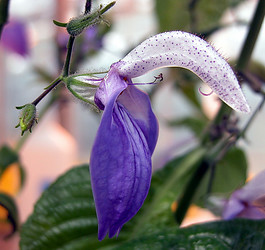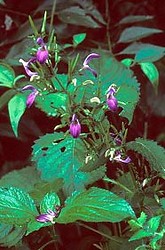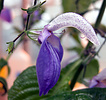Brillantaisia
Erin TrippIntroduction
The genus Brillantaisia contains ca. 20 species distributed in tropical Africa and Madagascar. Species are large herbs with prominent, quadrangular stems. Plants have attractive purple, bilabiate flowers that are “hooded” in appearance. They are likely predominantly bee-pollinated. The articulation of the fused corolla lobes permits a pivoting motion that brings stamens into contact with floral visitors (K. Sidwell, unpub. data). Brillantaisia species have two fertile stamens (and two staminodes), like other genera in Ruellieae (e.g. Eranthemum, Louteridium, and Sanchezia). The filament curtain in Brillantaisia is of a particular type, being formed in part by the inward folding of portions of the corolla (Manktelow 2000). This morphology probably aids in the floral movement mechcanism.
References
Kullenberg, B. 1955. Quelques observations sur les Apides en Côte d’Ivoire faites en août 1954. Bull. Inst. Français d’Afrique Noire. Série A. 17A(4): 1125-1131.
Manktelow, M. 2000. The filament curtain: a structure important to systematics and pollination biology in the Acanthaceae. Bot. Journ. Linn. Soc. 133: 129-160.
Sidwell, K.J. 1998. A revision of Brillantaisia (Acanthaceae). Bull. Nat. Hist. Museum, Botany Series. 28: 67-113.
Sidwell, K.J. Unpublished MS. Notes on the Pollination biology of Brillantaisia P. Beauv. (Acanthaceae).
Title Illustrations

| Scientific Name | Brillantaisia nyanzarum Burkill (Ruellieae) |
|---|---|
| Location | Greenhouse, Duke University |
| Specimen Condition | Live Specimen |
| Identified By | E. A. Tripp |
| Copyright |
© 2006

|
| Scientific Name | Brillantaisia owariensis P. Beauv. |
|---|---|
| Specimen Condition | Live Specimen |
| Copyright | © 2003 J. B. Carroll, M. Gage, L. Hurst & N. Maddison |
About This Page

Rancho Santa Ana Botanic Garden
Correspondence regarding this page should be directed to Erin Tripp at
Page copyright © 2006
All Rights Reserved.
- First online 13 November 2006
- Content changed 13 November 2006
Citing this page:
Tripp, Erin. 2006. Brillantaisia. Version 13 November 2006 (under construction). http://tolweb.org/Brillantaisia/65588/2006.11.13 in The Tree of Life Web Project, http://tolweb.org/










 Go to quick links
Go to quick search
Go to navigation for this section of the ToL site
Go to detailed links for the ToL site
Go to quick links
Go to quick search
Go to navigation for this section of the ToL site
Go to detailed links for the ToL site